It has been raining Huawei/Honor smartphones lately as the company tries to displace arch-rival Xiaomi when it comes to the budget segment. Having launched the Honor 7A and 7C below the Rs 10,000 price bracket, they had to offer more in the Rs 10,000-15,000 price bracket and what better way to do it in 2018 than throwing in a smartphone with a notch. [caption id=“attachment_4872961” align=“alignnone” width=“1024”] The Honor 9N is the successor to last year’s Honor 9i and is priced at Rs 11,999 for the base variant. Image: tech2/ Shomik Sen Bhattacharjee[/caption] The Honor 9N is Huawei’s answer to the Asus ZenFone Max Pro M1 and the Moto G6. Starting at Rs 11,999 for the base variant with 3 GB RAM and 32 GB storage, the 9N may require you to shell out up to Rs 17,999 for the top end variant with 4 GB RAM and 128 GB storage. That does seem like a lot to pay for extra RAM and storage but given the fact that no other smartphone from direct rivals offers a notch at the price, Honor could be banking heavily on it for sales. However, internally there’s nothing new on offer. We have similar camera setup that we saw on the Honor 9 Lite and the same chipset we saw on last year’s Honor 9i. So does an updated design and a price cut of sorts do enough to warrant a purchase? Let’s find out. Build and Design: 8/10 One thing that Honor has had going for it is that their phones look stylish at the budgets they sell in, and the Honor 9N is no different. At first glance, the smartphone looks almost identical to the Huawei P20 Lite from the front. The back, on the other hand, looks exactly like the Honor 9 Lite launched earlier this year. [caption id=“attachment_4872971” align=“alignnone” width=“1280”]
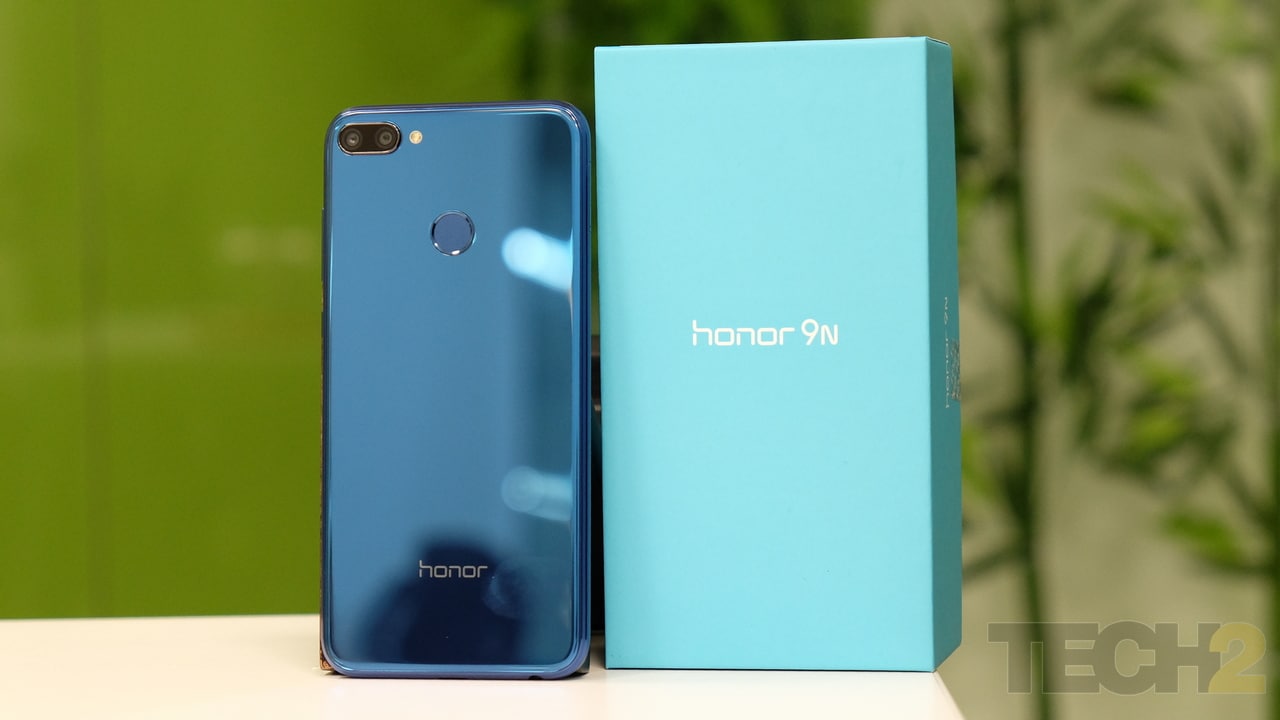 The Honor 9N gets a 2.5D glass on the back as well as on the front. Image: tech2/ Amrita Rajput[/caption] The Honor 9N features a 5.84-inch display which feels snug in hand and is good for one hand usage. A reason for the same is the high screen-to-body ratio, which is about 80 percent, meaning there’s a lot of display and very little bezel, apart from the bottom chin which has the Honor branding. The bezels are not thin enough to write home about but certainly adds to the appeal of the device. The one thing different on the front, from the Honor 9 Lite, is that the bezels are black in colour and do not match the colour variant of the phone. The 2.5D glass which curves around the plastic shell of the phone also helps with grip and makes it feel more premium than what the price may suggest. The notch houses the front facing camera, the earpiece, and the proximity sensor. Honor has also been able to fit in a tiny LED notification light into the notch which is commendable. [caption id=“attachment_4873061” align=“alignnone” width=“1280”]
The Honor 9N gets a 2.5D glass on the back as well as on the front. Image: tech2/ Amrita Rajput[/caption] The Honor 9N features a 5.84-inch display which feels snug in hand and is good for one hand usage. A reason for the same is the high screen-to-body ratio, which is about 80 percent, meaning there’s a lot of display and very little bezel, apart from the bottom chin which has the Honor branding. The bezels are not thin enough to write home about but certainly adds to the appeal of the device. The one thing different on the front, from the Honor 9 Lite, is that the bezels are black in colour and do not match the colour variant of the phone. The 2.5D glass which curves around the plastic shell of the phone also helps with grip and makes it feel more premium than what the price may suggest. The notch houses the front facing camera, the earpiece, and the proximity sensor. Honor has also been able to fit in a tiny LED notification light into the notch which is commendable. [caption id=“attachment_4873061” align=“alignnone” width=“1280”]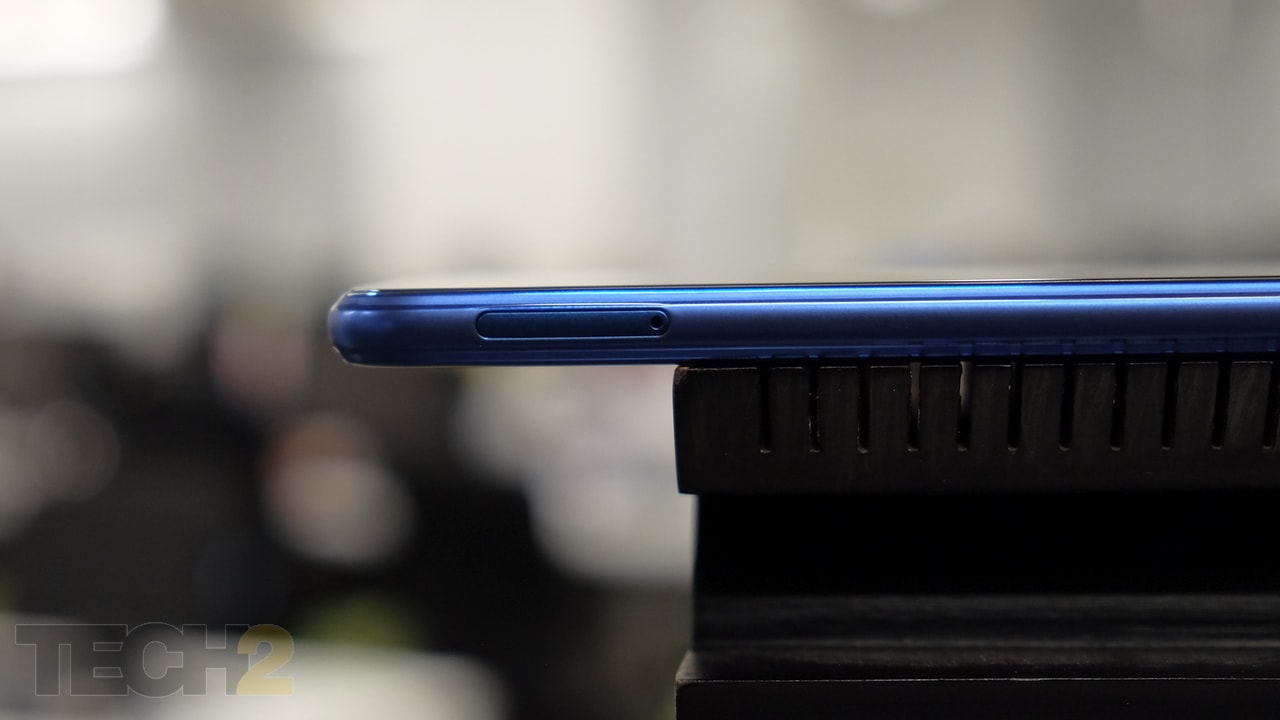 The Honor 9N houses a dual-SIM tray on the left side. Image: tech2/ Shomik Sen Bhattacharjee[/caption] Turn the phone around and you see a glossy finish that does seem to have turned into an Honor/Huawei trademark of late. The horizontal dual-camera placement on the top left along with an LED flash alongside is reminiscent of the Honor 9 Lite and looks just as stylish. The phone is also not too heavy at 152 g and the camera bump on the back is negligible, making the phone easy to use while keeping it on a table. As for buttons and ports, you have the power and volume rockers on the right and the dual SIM tray on the left. Down below you have a micro USB slot for charging and the speaker grille followed by a 3.5 mm headphone jack. Features: 7.5/10 Honor has been releasing phones quite frequently of late and it is difficult to keep up with which phone has what specifications. But thanks to the naming convention Honor sticks to, you can at least separate out the chipset it’s housing. [caption id=“attachment_4872981” align=“alignnone” width=“1280”]
The Honor 9N houses a dual-SIM tray on the left side. Image: tech2/ Shomik Sen Bhattacharjee[/caption] Turn the phone around and you see a glossy finish that does seem to have turned into an Honor/Huawei trademark of late. The horizontal dual-camera placement on the top left along with an LED flash alongside is reminiscent of the Honor 9 Lite and looks just as stylish. The phone is also not too heavy at 152 g and the camera bump on the back is negligible, making the phone easy to use while keeping it on a table. As for buttons and ports, you have the power and volume rockers on the right and the dual SIM tray on the left. Down below you have a micro USB slot for charging and the speaker grille followed by a 3.5 mm headphone jack. Features: 7.5/10 Honor has been releasing phones quite frequently of late and it is difficult to keep up with which phone has what specifications. But thanks to the naming convention Honor sticks to, you can at least separate out the chipset it’s housing. [caption id=“attachment_4872981” align=“alignnone” width=“1280”]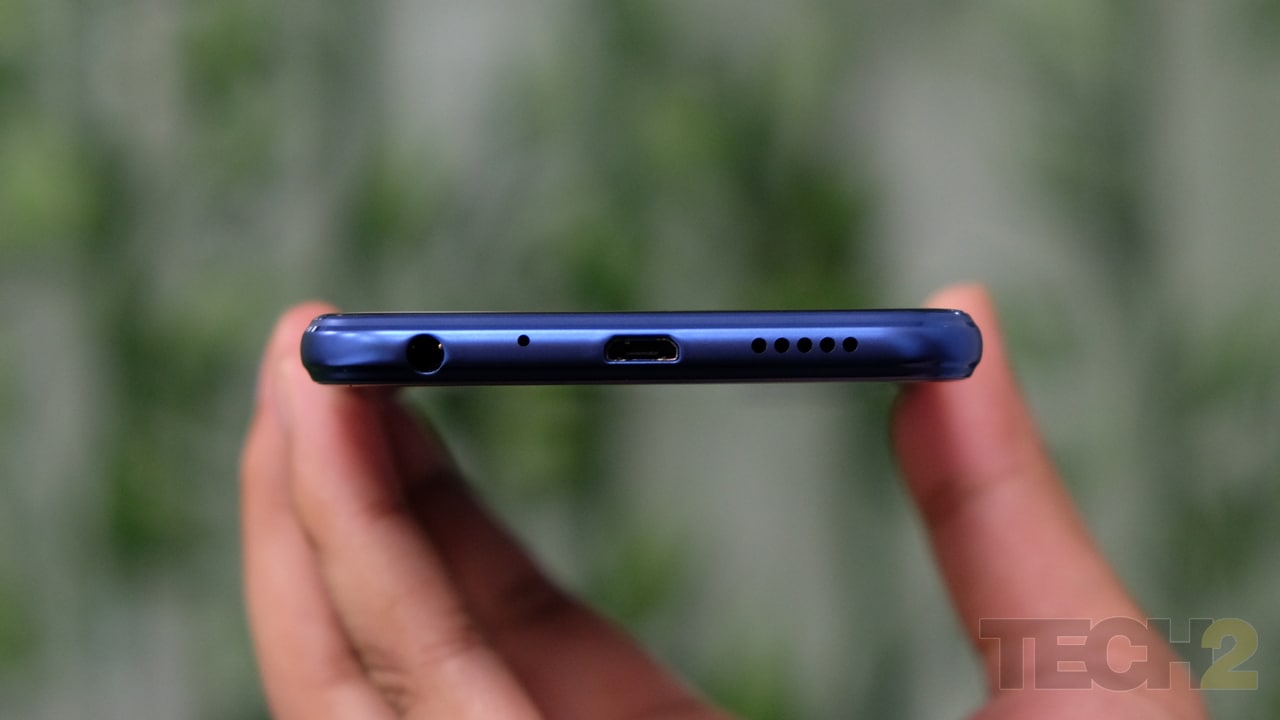 The Honor 9N gets a micro USB port which is a bit of a disappointment in 2018. Image: tech2/ Amrita Rajput[/caption] So the Honor 9N, much like the Honor 9 Lite and the Honor 9i before it, houses the 16 nm HiSilicon Kirin 659 chipset. It has a four Cortex A53 cores clocked at 2.36 GHz and four Cortex A53 cores clocked at 1.7 GHz for the low-power tasks. On the graphics front, you have a Mali T830 MP2 GPU. The unit we received for review comes with 4 GB RAM and 64 GB storage which is the mid-tier variant. On booting it for the first time, you roughly get 52.8 GB of storage, which is passable. As for the display, the Honor 9N sports a 5.84-inch LCD display with a 19:9 aspect ratio. Honor has also thrown in a 3,000 mAh battery to power the smartphone. No surprises on the software end as the 9N comes with Huawei’s EMUI 8.0 built on top of Android Oreo 8.1. As for optics, the 9N features a 13 MP + 2 MP camera setup on the back and a single 16 MP camera on the front. The rear setup also gets an LED flash and features a phase-detection autofocus system. Connectivity options include support for dual SIM cards (4G LTE + 3G), Wi-Fi, Bluetooth 4.2, GPS. There’s a 3.5 mm headphone jack at the bottom and a microUSB port for data transfers and charging. [caption id=“attachment_4873041” align=“alignnone” width=“1280”]
The Honor 9N gets a micro USB port which is a bit of a disappointment in 2018. Image: tech2/ Amrita Rajput[/caption] So the Honor 9N, much like the Honor 9 Lite and the Honor 9i before it, houses the 16 nm HiSilicon Kirin 659 chipset. It has a four Cortex A53 cores clocked at 2.36 GHz and four Cortex A53 cores clocked at 1.7 GHz for the low-power tasks. On the graphics front, you have a Mali T830 MP2 GPU. The unit we received for review comes with 4 GB RAM and 64 GB storage which is the mid-tier variant. On booting it for the first time, you roughly get 52.8 GB of storage, which is passable. As for the display, the Honor 9N sports a 5.84-inch LCD display with a 19:9 aspect ratio. Honor has also thrown in a 3,000 mAh battery to power the smartphone. No surprises on the software end as the 9N comes with Huawei’s EMUI 8.0 built on top of Android Oreo 8.1. As for optics, the 9N features a 13 MP + 2 MP camera setup on the back and a single 16 MP camera on the front. The rear setup also gets an LED flash and features a phase-detection autofocus system. Connectivity options include support for dual SIM cards (4G LTE + 3G), Wi-Fi, Bluetooth 4.2, GPS. There’s a 3.5 mm headphone jack at the bottom and a microUSB port for data transfers and charging. [caption id=“attachment_4873041” align=“alignnone” width=“1280”] The Notch is one of the Honor 9N’s key selling points. Image: tech2/ Amrita Rajput[/caption] Display: 8/10 One of the biggest selling points for Honor 9N is certainly the notch. Given the starting price of the phone which is Rs 11,999, there are not many options for you to choose from when it comes to notched displays. If you’re not a fan of it, however, you can still choose to switch it off under display settings, though it is noticeable, thanks to the LCD display. That said, the Honor 9N gets the same treatment that we had seen on the Huawei P20 Lite. The phone packs a 5.84-inch FHD+ LCD panel with a resolution of 2280 x 1080 pixels and an aspect ratio of 19:9. The display is certainly one of the better LCD displays you can get with good, natural-looking tones. The white balance is slightly on the blueish side though you can opt for a warmer tone in the settings. [caption id=“attachment_4873021” align=“alignnone” width=“1280”]
The Notch is one of the Honor 9N’s key selling points. Image: tech2/ Amrita Rajput[/caption] Display: 8/10 One of the biggest selling points for Honor 9N is certainly the notch. Given the starting price of the phone which is Rs 11,999, there are not many options for you to choose from when it comes to notched displays. If you’re not a fan of it, however, you can still choose to switch it off under display settings, though it is noticeable, thanks to the LCD display. That said, the Honor 9N gets the same treatment that we had seen on the Huawei P20 Lite. The phone packs a 5.84-inch FHD+ LCD panel with a resolution of 2280 x 1080 pixels and an aspect ratio of 19:9. The display is certainly one of the better LCD displays you can get with good, natural-looking tones. The white balance is slightly on the blueish side though you can opt for a warmer tone in the settings. [caption id=“attachment_4873021” align=“alignnone” width=“1280”]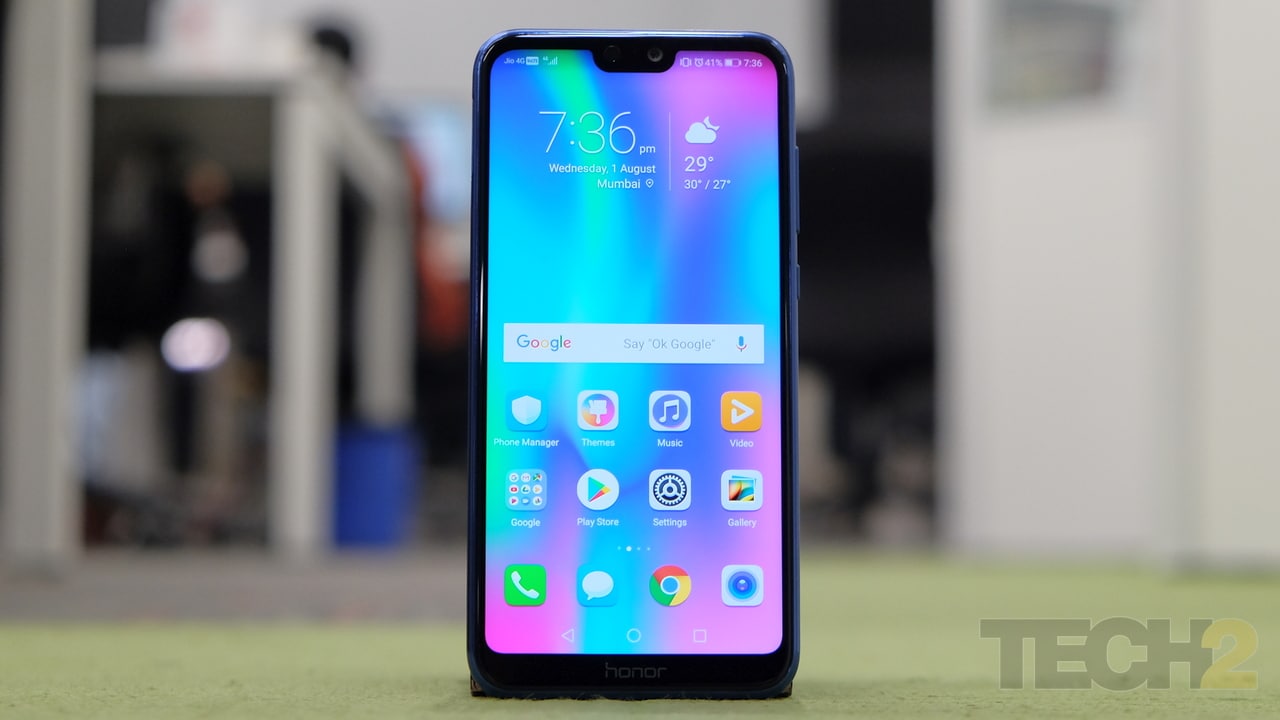 The 5.84-inch display is plenty sharp and gets quite bright. Image: tech2/ Amrita Rajput[/caption] Brightness levels were also great, which was surprising since this is an LCD panel. Viewing the phone even under bright sunlight was not an issue. The minimum brightness levels are also impressive, which does come handy if you tend to use your phone in dark conditions. Honor also throws in an ‘Eye Care’ mode for readers. Given the price of the 9N, I would say that the display is better than that on the Moto G6 and at par with the Asus ZenFone Max Pro M1. OS and Software: 6.5/10 The Honor 9 Lite comes bundled with Android 8.0 Oreo out of the box with Huawei’s Emotion UI or EMUI 8.0 skin atop it. This is the same feature-packed skin we’d seen on the Honor 9 Lite earlier this year. We would have expected Huawei to throw in EMUI 8.1 but that sadly did not happen. Bear in mind that Huawei uses a lighter version of EMUI on their budget smartphones and the 9N is no different. I personally don’t particularly love skinned versions of Android and tend to sway more towards stock Android, but if you do love to change up things on your phone, you will love EMUI. You also get the June Security patch which should have you covered against any security let-ups. [caption id=“attachment_4805731” align=“alignnone” width=“1280”]
The 5.84-inch display is plenty sharp and gets quite bright. Image: tech2/ Amrita Rajput[/caption] Brightness levels were also great, which was surprising since this is an LCD panel. Viewing the phone even under bright sunlight was not an issue. The minimum brightness levels are also impressive, which does come handy if you tend to use your phone in dark conditions. Honor also throws in an ‘Eye Care’ mode for readers. Given the price of the 9N, I would say that the display is better than that on the Moto G6 and at par with the Asus ZenFone Max Pro M1. OS and Software: 6.5/10 The Honor 9 Lite comes bundled with Android 8.0 Oreo out of the box with Huawei’s Emotion UI or EMUI 8.0 skin atop it. This is the same feature-packed skin we’d seen on the Honor 9 Lite earlier this year. We would have expected Huawei to throw in EMUI 8.1 but that sadly did not happen. Bear in mind that Huawei uses a lighter version of EMUI on their budget smartphones and the 9N is no different. I personally don’t particularly love skinned versions of Android and tend to sway more towards stock Android, but if you do love to change up things on your phone, you will love EMUI. You also get the June Security patch which should have you covered against any security let-ups. [caption id=“attachment_4805731” align=“alignnone” width=“1280”]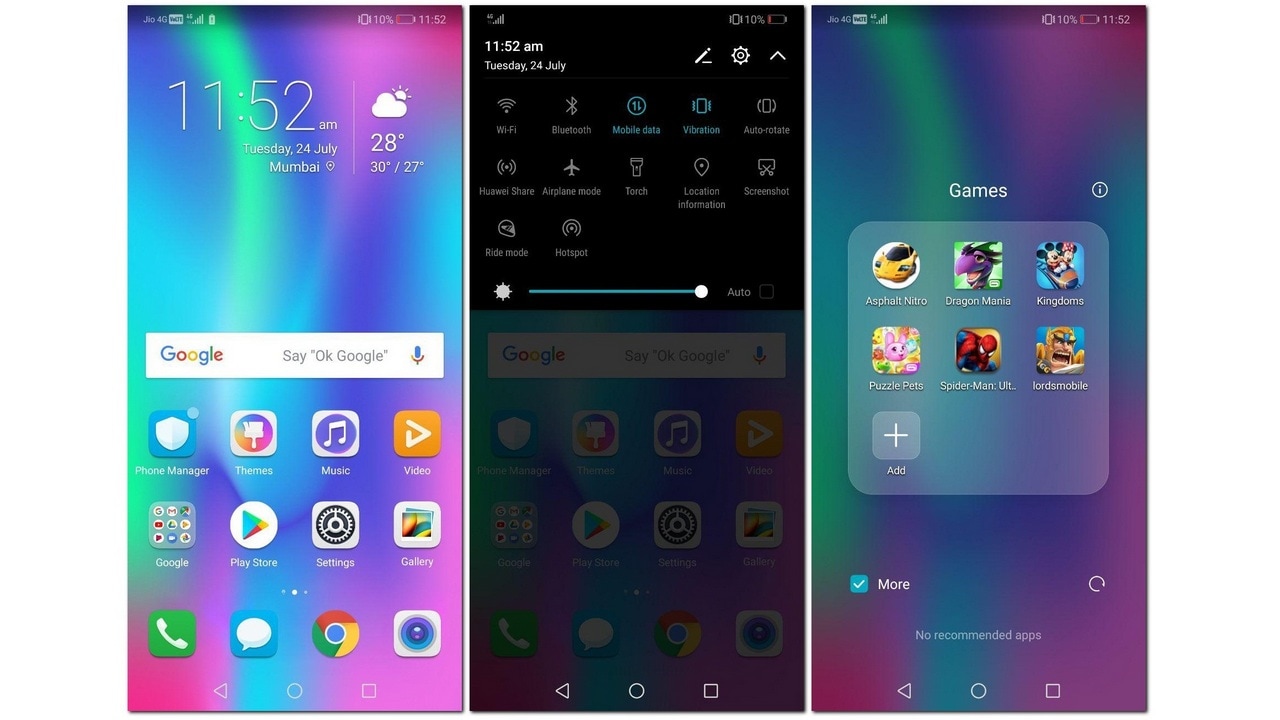 EMUI 8.1 on the Honor 9N. Image: tech2/ Shomik Sen Bhattacharjee[/caption] That said, when I say feature-packed, EMUI comes with a ton of options for customisations, starting with the navigation keys which can be hidden to a home screen with or without an app drawer. There’s a smart split screen which understands how much screen-space you need based on the apps being used in split screen mode. But that’s where all the good bits come to an end. The Honor 9N comes with a ton of bloat starting with Honor’s own Weather, HiCare, Mirror, Honor Club and a few other utility apps, to third-party apps like Netflix, Messenger and Truecaller. It doesn’t end there. The phone also comes with as many as six pre-installed games. You do get the option to uninstall all the third-party apps but they do take up a fair bit of available space on the phone. [caption id=“attachment_4873031” align=“alignnone” width=“1280”]
EMUI 8.1 on the Honor 9N. Image: tech2/ Shomik Sen Bhattacharjee[/caption] That said, when I say feature-packed, EMUI comes with a ton of options for customisations, starting with the navigation keys which can be hidden to a home screen with or without an app drawer. There’s a smart split screen which understands how much screen-space you need based on the apps being used in split screen mode. But that’s where all the good bits come to an end. The Honor 9N comes with a ton of bloat starting with Honor’s own Weather, HiCare, Mirror, Honor Club and a few other utility apps, to third-party apps like Netflix, Messenger and Truecaller. It doesn’t end there. The phone also comes with as many as six pre-installed games. You do get the option to uninstall all the third-party apps but they do take up a fair bit of available space on the phone. [caption id=“attachment_4873031” align=“alignnone” width=“1280”]![]() EMUI 8.0 comes with a ton of customisations. Image: tech2/ Amrita Rajput[/caption] There’s also the issue of the animations being too heavy which results in a choppy experience when pushing the phone. In fact, even while just scrolling past menus, you might notice an occasional lag which goes on to prove how heavy the skin is overall. Honor’s decision of sticking to the ageing Kirin 659 chipset also could be put to blame here, but overall, you should be happy with the sheer amount of customisations that EMUI provides. Hopefully, users do get an upgrade to Android Oreo 8.1 or even Android P when it’s available. Performance: 6/10 The Kirin 659 SoC is something that we’ve seen on a lot of Huawei and Honor devices over the last few months. It was launched as a chip for its mid-range offerings like the Honor 9i and the Honor 7X, but we’ve also seen the chipset feature on the Rs 10,999 priced Honor 9 Lite and the much higher priced Huawei P20 Lite. [caption id=“attachment_4873081” align=“alignnone” width=“1280”]
EMUI 8.0 comes with a ton of customisations. Image: tech2/ Amrita Rajput[/caption] There’s also the issue of the animations being too heavy which results in a choppy experience when pushing the phone. In fact, even while just scrolling past menus, you might notice an occasional lag which goes on to prove how heavy the skin is overall. Honor’s decision of sticking to the ageing Kirin 659 chipset also could be put to blame here, but overall, you should be happy with the sheer amount of customisations that EMUI provides. Hopefully, users do get an upgrade to Android Oreo 8.1 or even Android P when it’s available. Performance: 6/10 The Kirin 659 SoC is something that we’ve seen on a lot of Huawei and Honor devices over the last few months. It was launched as a chip for its mid-range offerings like the Honor 9i and the Honor 7X, but we’ve also seen the chipset feature on the Rs 10,999 priced Honor 9 Lite and the much higher priced Huawei P20 Lite. [caption id=“attachment_4873081” align=“alignnone” width=“1280”] Playing Shadowgun Legends was a pain due to the dropped frames.[/caption] Performance wise, the Honor 9N is proof of the fact that the Kirin 659 is beginning to age. Huawei recently launched the Kirin 710 which is expected to be the successor to the 659, but for now, you are still stuck with the older 16 nm chip. While less intensive games like Leo’s Fortune and Alto’s Adventure played fine, moving to even moderately heavier titles showed a sharp drop in textures as well as frames. Just like the Huawei P20 Pro, the Honor 9N fails to run heavier titles like Asphalt Xtreme and Shadowguns Legends. I did notice some optimisation issues, as well as newer games like Asphalt 9, just don’t show up on the Play Store. Thermally, I did not notice any major heating issues even with extended gaming sessions. As for audio quality, it was decent through the headphones with balanced output. The mono speaker is not too great either but it does get adequately loud. Call quality was great as well, but because of the phone having a tiny earpiece, you do have to ensure that you are holding the phone just right to be able to hear optimally. This does seem like an issue that needs to be addressed as we had the same problem with the Huawei P20 Lite as well. Camera: 7.5/10 If there had to be one segment where the Honor 9N will surprise you, it surely is the camera. The Honor 9N comes with a dual-lens setup on the back which comprises of a 13 MP f/2.2 aperture primary lens along with a 2 MP sensor meant for capturing depth information. This might seem passable on paper but the results are quite impressive, given the competition. The camera interface is simple and easy to get used to. You swipe right to access all the modes which include — Pro Mode, AR Lens mode, Night Shot, Light Painting, Panorama, Timelapse and HDR modes. Swiping to the left, on the other hand, lets you access the camera settings. There’s no AI mode here which you do get on premium Honor devices.
Playing Shadowgun Legends was a pain due to the dropped frames.[/caption] Performance wise, the Honor 9N is proof of the fact that the Kirin 659 is beginning to age. Huawei recently launched the Kirin 710 which is expected to be the successor to the 659, but for now, you are still stuck with the older 16 nm chip. While less intensive games like Leo’s Fortune and Alto’s Adventure played fine, moving to even moderately heavier titles showed a sharp drop in textures as well as frames. Just like the Huawei P20 Pro, the Honor 9N fails to run heavier titles like Asphalt Xtreme and Shadowguns Legends. I did notice some optimisation issues, as well as newer games like Asphalt 9, just don’t show up on the Play Store. Thermally, I did not notice any major heating issues even with extended gaming sessions. As for audio quality, it was decent through the headphones with balanced output. The mono speaker is not too great either but it does get adequately loud. Call quality was great as well, but because of the phone having a tiny earpiece, you do have to ensure that you are holding the phone just right to be able to hear optimally. This does seem like an issue that needs to be addressed as we had the same problem with the Huawei P20 Lite as well. Camera: 7.5/10 If there had to be one segment where the Honor 9N will surprise you, it surely is the camera. The Honor 9N comes with a dual-lens setup on the back which comprises of a 13 MP f/2.2 aperture primary lens along with a 2 MP sensor meant for capturing depth information. This might seem passable on paper but the results are quite impressive, given the competition. The camera interface is simple and easy to get used to. You swipe right to access all the modes which include — Pro Mode, AR Lens mode, Night Shot, Light Painting, Panorama, Timelapse and HDR modes. Swiping to the left, on the other hand, lets you access the camera settings. There’s no AI mode here which you do get on premium Honor devices.
Moving to the performance of the rear-cameras, colours and skin tones remained neutral, while the dynamic range fell a bit short leading to overexposed areas in brightly lit scenarios. This applied to the front camera as well. [Refer to selfies in the Flickr album below] Focusing speeds were quick in daylight but that took a hit once you moved to dimmer lighting. In very low-lighting conditions, the focus accuracy was not up to the mark with most photos appearing blurry at best. If you do hold on firm, for a second or two, you will end up with quite a few decent shots with good levels of detail and sharpness. [caption id=“attachment_4873051” align=“alignnone” width=“1280”] The rear-camera setup does show for some great results on the Honor 9N. Image: tech2/ Shomik Sen Bhattacharjee[/caption] The portrait mode with the bokeh effect on, delivered sharp and detailed looking images in daylight though edge detection was average overall. I ended up with photos in which not only people but even objects not separating from the backgrounds accurately. The regular selfie mode is more preferable here as the 16 MP sensor packs in quite a punch. As for the different modes, I did try out the panorama and night shot mode with average results. While panorama fails to pack in a lot of detail, night mode did do a decent job in low-lighting situations. HDR seemed quite pointless to me as it made little difference to pictures, even while looking at highlights.
Video recording (capped at 1080p) on the Honor 9N was decent with everything being overexposed when using the selfie camera. The dynamic range was better with the rear camera, but the videos are too jerky despite being clear and you have to have really steady hands to keep the footage jitter free. Overall, the camera performance on the Honor 9N is marginally better than the Moto G6, given the price range, but definitely nowhere close to the Redmi Note 5 Pro’s camera output. Overall, the smartphone turned out to be a decent daily casual snapper but if you are considering buying it solely for the camera, you might want to look elsewhere. Battery Life: 7/10 I was disappointed initially seeing the Honor 9N pack a 3,000 mAh battery, but over my period of testing the device, I did return surprised. While our standard PC Mark Work 2.0 Battery Life test barely made it to the 7-hour mark, day to day usage saw it last well beyond a day with casual use. Even on the busiest of days with plenty of calls and emails coming through, the Honor 9N still had more than 20 percent of battery life left before I plugged it in for charging. This is surely commendable considering the phone runs a 16 nm chip. Honor does need to improve charging speeds though as it took me more than 2 hours to juice the phone up from about 15 percent to 90 percent. Verdict and Price in India The Honor 9i was launched at a price of Rs 17,999 last year, which was a little on the higher side of things, considering how the smartphone performed. The Honor 9N is a 2018 refresh of the smartphone with a notch. However, Honor did slash the price of the smartphone by Rs 6,000 making it far more compelling. [caption id=“attachment_4873001” align=“alignnone” width=“1280”]
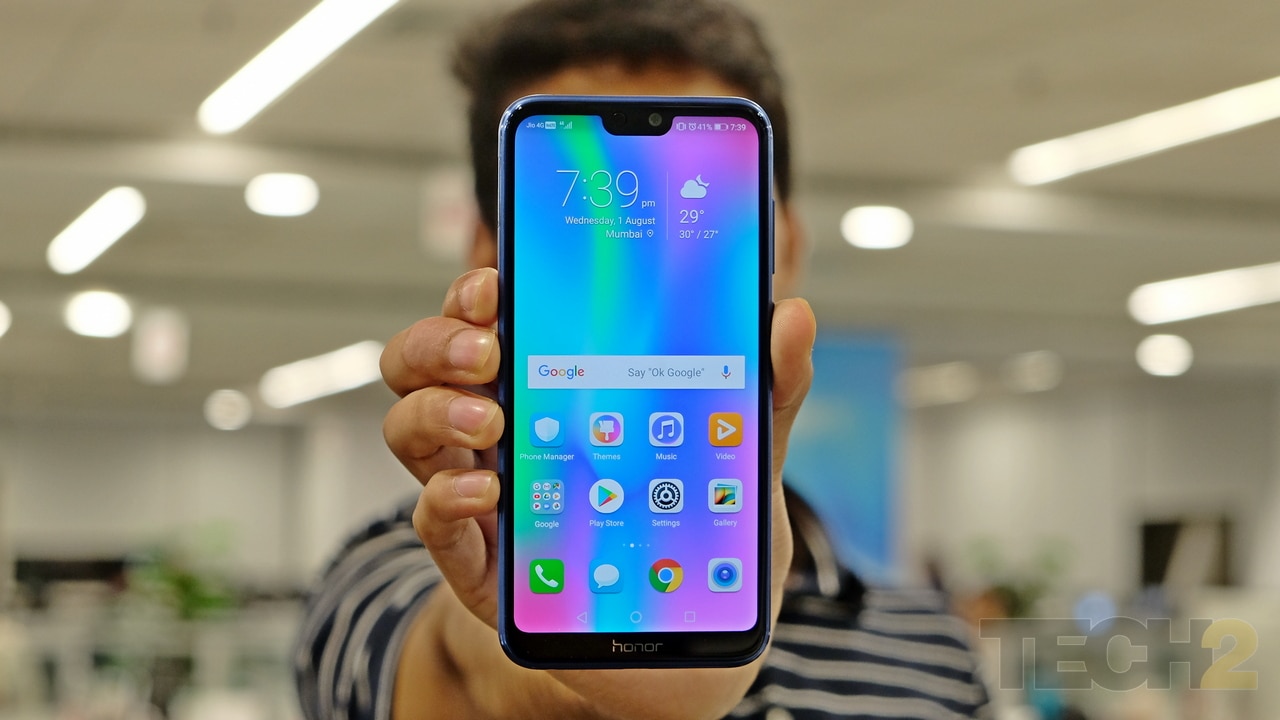 The Honor 9N loses out heavily to the Asus ZenFone Max Pro M1 when it comes to performance. Image: tech2/ Amrita Rajput[/caption] As more and more manufacturers start to pack more into their budget offerings, even with a price tag of Rs 11,999, the Honor 9N goes straight up against the Asus ZenFone Max Pro M1 and the Moto G6 which are two very compelling devices at the price. The Honor 9N is not a replacement for the Honor 9 Lite, but could be considered an alternative with the same specs, but with a notch. If you are not to keen on the notch, the 9 Lite still makes for a better purchase. While it does match the quality of both the Moto G6 and the ZenFone Max Pro M1 in terms of camera performance and looks far more appealing than both the phones, its the ageing chipset paired with the EMUI skin which brings the Honor 9N down. That said, if you want a notch on your phone, neither of its contenders have that on offer, so it makes selecting the phones easier for you.
The Honor 9N loses out heavily to the Asus ZenFone Max Pro M1 when it comes to performance. Image: tech2/ Amrita Rajput[/caption] As more and more manufacturers start to pack more into their budget offerings, even with a price tag of Rs 11,999, the Honor 9N goes straight up against the Asus ZenFone Max Pro M1 and the Moto G6 which are two very compelling devices at the price. The Honor 9N is not a replacement for the Honor 9 Lite, but could be considered an alternative with the same specs, but with a notch. If you are not to keen on the notch, the 9 Lite still makes for a better purchase. While it does match the quality of both the Moto G6 and the ZenFone Max Pro M1 in terms of camera performance and looks far more appealing than both the phones, its the ageing chipset paired with the EMUI skin which brings the Honor 9N down. That said, if you want a notch on your phone, neither of its contenders have that on offer, so it makes selecting the phones easier for you.


)
)
)
)
)
)
)
)
)



